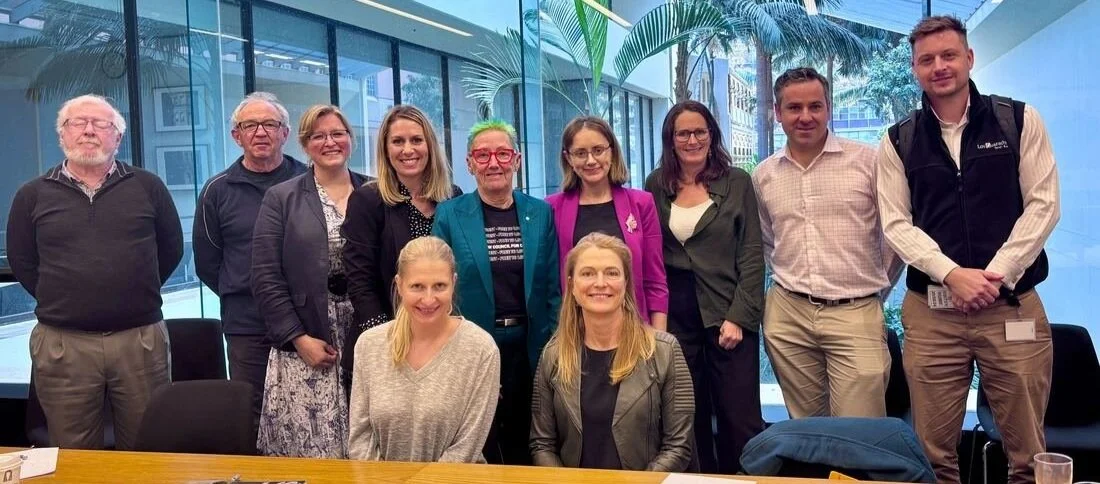Paving the Way For Better Policies in NSW
Better Streets was recently invited by The Greens’ Cate Faehrmann and Kobi Shetty to NSW Parliament House for a discussion about shared streets in NSW. Alongside our colleagues from Walk Sydney, Bicycle NSW, 30Please and Inner West Bicycle Coalition, we explored how The Greens could shape their policies to ensure more inclusive, safer and environmentally-friendly streets and communities.
We welcomed this opportunity to collaborate with The Greens on developing sensible policies for sustainable transport and healthy streets. We are open to working with any party interested in fostering a more inclusive and sustainable transport future for communities around Australia.
In our workshop, we proposed three key infrastructure recommendations and three enablers to ensure the best outcomes for our communities, which are outlined in further detail below.
Infrastructure:
1. Introduce a 30km/h default Urban Speed Limit
2. Allocate 20% of the transport budget to Active Transport
3. Focus on schools to enable 75% of children to walk, cycle or use public transport.
Enablers:
4. Undertake a deep reform of transport across state and local governments
5. Establish a Carbon Budget for all sectors, including transport
6. Embed a fully integrated approach to transport and land use planning.
Recommendation 1. Introduce a 30km/h default Urban Speed Limit
At 30km/h drivers have a wider field of vision and a greater chance of noticing potential hazards and stopping in time. At this speed most people, including children and the elderly, will survive a collision. Reduced speeds also make streets quieter, reduce noise pollution and encourage more people to walk and cycle. More detail about our position is at Slow vehicles down - Better Streets.
Recommendation 2. Allocate 20% of the transport budget to Active Transport
To achieve a substantial mode shift and reduce carbon emissions from transport, investment must be redirected to active and public transport. Countries like Ireland and Sweden allocate 18-20% of their transport budgets to active transport. Adopting this approach in NSW, in conjunction with our other recommendations, would transform our streets - much like Paris has done in recent years.
Recommendation 3. Focus on schools to enable 75% of children to walk, cycle, or use public transport
Focusing on schools is crucial for creating a safe and encouraging environment for children. Improving infrastructure around schools to enable children to walk independently, improves their health and wellbeing and significantly reduces traffic congestion and pollution around schools. See our position at Better Streets at school - Better Streets
Recommendation 4. Undertake a deep reform of transport
We believe the time has come for a deep review of Transport for NSW (TfNSW) and local governments to address the systemic issues hindering optimal outcomes. Key actions that we recommend include:
Establish a Commission of Reform or Parliamentary Inquiry.
Establish an Active Transport Commissioner.
Host the Parliamentary Friends of Active Transport every quarter, with a focus on action.
Sign an MoU between the Departments responsible for transport, climate, health, education, planning and housing - to recognise the co-benefits and ensure a joined-up approach.
Develop and publish whole-of-agency performance targets for TfNSW, similar to those at Transport for London. This would set out clear targets that are tied to executive performance pay for:
a) mode shift to sustainable transport
b) carbon reduction
c) better streets outcomes (30kmh, cycleways, crossings)
d) reduction in pedestrian and bicycle-rider fatalities.
Prepare a procedure to accompany the TfNSW corporate policy requiring all transport projects to deliver walking and cycling (similar to the Road User Space Allocation policy and procedure).
Recommendation 5. Establish a Carbon Budget for all sectors, including transport
NSW should implement a carbon budget for all sectors to meet legislated carbon reduction targets for 2030, 2035 and 2050. This would entail setting five-year carbon budgets that progressively decrease for each sector, including transport.
In Wales, the Well-being of Future Generations Act (2015) created a legal obligation for all public bodies to ensure they don’t compromise future generations, while the Net Zero Wales Carbon Budget requires agencies to ensure that every decision keeps the agency within its allocated carbon budget. A Roads Review panel found most road projects needed to be halted because of their anticipated embodied carbon and operational emissions. It did not accept rising traffic forecasts as justification for increased road capacity, highlighting the need to focus on sustainable transport solutions instead. We strongly recommend that NSW adopt a similar approach.
Recommendation 6. Embed a fully integrated approach to transport and land use planning
If we are serious about reducing emissions and conclude, as the Welsh Government did, that road building needs to be halted, then we need to re-think our planning for urban areas. Better Streets argues that state and local governments should immediately reject all new developments that perpetuate car dependency for current and future generations. Instead, we should support compact, efficient urban forms. This involves prioritising infill over greenfield development.
The NSW Government’s commitment to Transit-Oriented Developments (TODs) is a first step, by increasing density around major public transport. However this also needs to be accompanied by a serious commitment to reduced traffic speeds, improved streetscapes and parklands, and better infrastructure provision for those communities.
If we cease building new roads, we can redirect funds to more sustainable initiatives, such as public and active transport, streetscape improvements and affordable housing. The Victorian Government subsidises greenfield areas by $170 000 per home which could instead fund affordable housing in infill areas. Infrastructure Victoria shows that compact development uses less land, encourages shorter driving distances, increases the use of active and public transport, and results in lower overall emissions.

